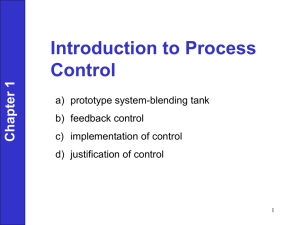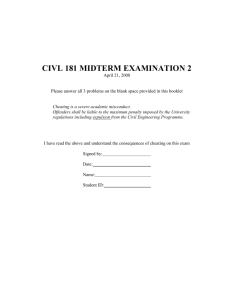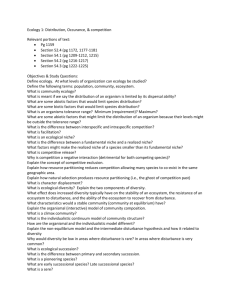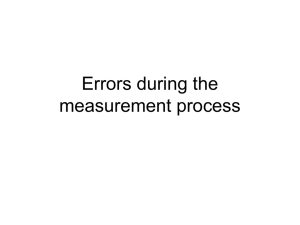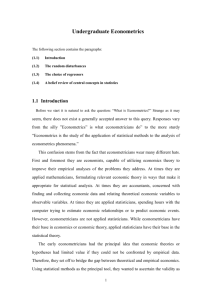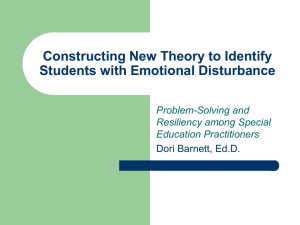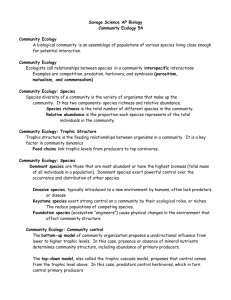jec12536-sup-0006-AppendixS2
advertisement
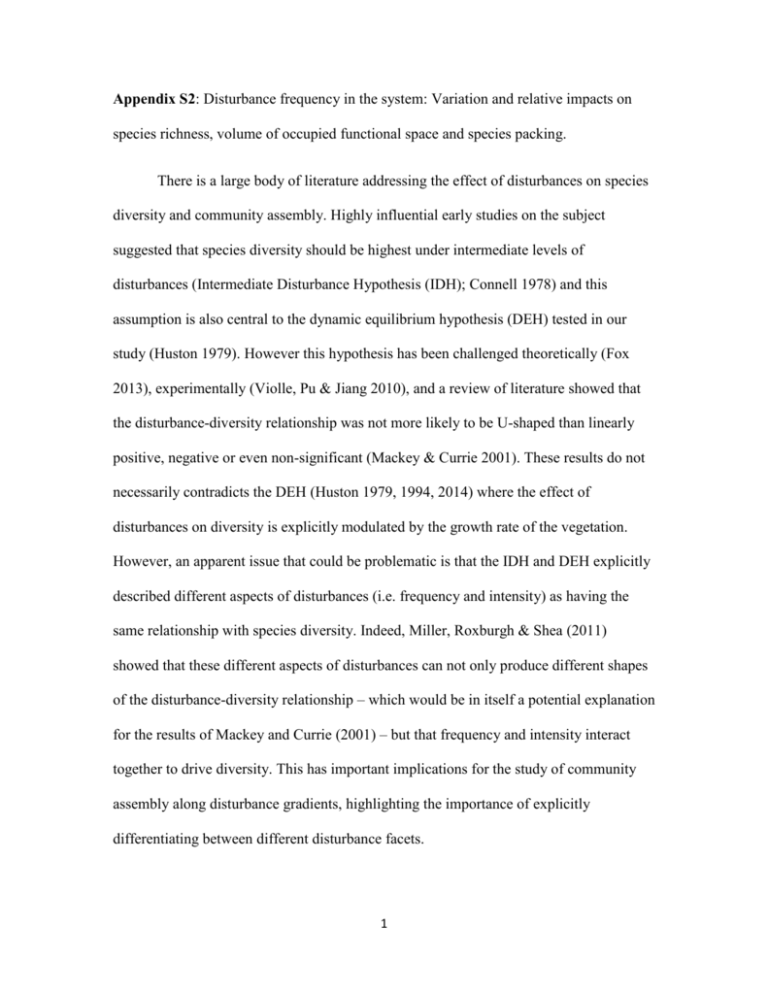
Appendix S2: Disturbance frequency in the system: Variation and relative impacts on species richness, volume of occupied functional space and species packing. There is a large body of literature addressing the effect of disturbances on species diversity and community assembly. Highly influential early studies on the subject suggested that species diversity should be highest under intermediate levels of disturbances (Intermediate Disturbance Hypothesis (IDH); Connell 1978) and this assumption is also central to the dynamic equilibrium hypothesis (DEH) tested in our study (Huston 1979). However this hypothesis has been challenged theoretically (Fox 2013), experimentally (Violle, Pu & Jiang 2010), and a review of literature showed that the disturbance-diversity relationship was not more likely to be U-shaped than linearly positive, negative or even non-significant (Mackey & Currie 2001). These results do not necessarily contradicts the DEH (Huston 1979, 1994, 2014) where the effect of disturbances on diversity is explicitly modulated by the growth rate of the vegetation. However, an apparent issue that could be problematic is that the IDH and DEH explicitly described different aspects of disturbances (i.e. frequency and intensity) as having the same relationship with species diversity. Indeed, Miller, Roxburgh & Shea (2011) showed that these different aspects of disturbances can not only produce different shapes of the disturbance-diversity relationship – which would be in itself a potential explanation for the results of Mackey and Currie (2001) – but that frequency and intensity interact together to drive diversity. This has important implications for the study of community assembly along disturbance gradients, highlighting the importance of explicitly differentiating between different disturbance facets. 1 The time interval since the last disturbance, as a measure of disturbance frequency, was recorded for each plot (see Fig. S2.1 for an illustration of the variation in disturbance frequency within sites). This was expressed in years, so that a plot disturbed (by mowing or grazing) twice a year has a value of 0.5 and a plot abandoned for 5 years has a value of 5. Unfortunately, and unlike disturbance intensity, not all sites did manipulate this variable, so that it varies mainly in 4 out of 8 sites (Fig. S2.1). We tested the ideas expressed in Mackey and Currie (2001) with mixed effect models in the same way as in the main manuscript but replacing disturbance intensity by disturbance frequency to see if different patterns in species richness, occupied volume of functional space and species packing variation would emerge. We also tested if any interaction between disturbance intensity and frequency in driving the taxonomic or functional metrics does exist, but none were detected (results not shown). The models for the variation in species richness showed that the patterns observed when using disturbance frequency (Fig. S2.2) were very similar to the ones found with disturbance intensity (Fig. 2 of the main manuscript). Only a few trends were not similar (e.g. Fig. S2.2, panel a) and these were related to extrapolation of the models, i.e. parts of the gradient for which no real data were available. On the contrary, the results of the models for the variation in occupied functional space (corrected for species richness) showed different results between models including disturbance intensity (Fig. 3) and frequency (Fig. S2.3). In the case of the models with disturbance frequency, the expected unimodal relationship between disturbance and functional diversity (Navas & Violle 2009) was clearly detected except under the most favorable climatic conditions (Fig. S2.3, panels d-f). Note that these unimodal trends depend again on extrapolations from 2 the model where no real data are available. For the species packing models, there was no effect of the nutrient index, regardless of the disturbance aspect used. Furthermore, using disturbance frequency instead of disturbance intensity led to a similarly general decrease in species packing with increasing disturbances (Fig. S2.4), except under unfavorable climatic conditions where there was a slight increase in species packing along the gradient of disturbance frequency. These results support (at least partially) the conclusions of Mackey & Currie (2001) by showing that functional diversity – and to a lesser extent taxonomic diversity – responds differently to different aspects of disturbance regimes. A thorough interpretation of these differences is difficult in our context (and out of the scope of this study) because disturbance frequency varied in 4 sites only. However, these results highlight the importance of specifically identifying which aspect of the disturbance regime is being considered and to take it into account for the interpretation. 3 Fig. S2.1. Boxplot of the frequency of disturbances measured at the plot level across the eight sites. The y-axis is log-scaled. 4 Fig. S2.2. Predicted species richness (SR) from a significant linear mixed model (see main manuscript for the construction of the models) along a nutrient index (NI; a, b, c) and disturbance frequency (DF; d, e, f) gradients. Grey sections of the curves indicate the range of values on the x-axis for which actual observed species richness values were not available, for each combination of the other variables. These sections are extrapolations from the models. Formula: SR ~ NI*DF*GSL + NI2*DF2 + NI2*GSL + DF2*GSL 5 Fig. S2.3. Predicted standardized values of occupied volume of functional space (occFSstand) from a significant linear mixed model (see main manuscript for the construction of the models) along nutrient index (NI; a, b, c) and disturbance frequency (DF; d, e, f) gradients. Grey sections of the curves indicate the range of values on the xaxis for which actual observed species richness values were not available, for each combination of the other variables. These sections are extrapolations from the models. Formula: occFSstand ~ NI*DF + NI*GSL + DF*GSL + DF2*GSL 6 Fig. S2.4. Predicted SES of species packing (SESPack) from a significant linear mixed model (see main manuscript for the construction of the models) along a disturbance frequency gradient. Grey sections of the curves indicate the range of values on the x-axis for which actual observed species richness values were not available, for each combination of the other variables. These sections are extrapolations from the models. Formula: SESPack ~ DF*GSL 7 REFERENCES Connell, J.H. (1978) Diversity in tropical rain forests and coral reefs. Science, 199, 1302– 1310. Fox, J.W. (2013) The intermediate disturbance hypothesis should be abandoned. Trends in ecology & evolution, 28, 86–92. Huston, M.A. (1979) A general hypothesis of species diversity. American naturalist, 113, 81–101. Huston, M.A. (1994) Biological Diversity: The Coexistence of Species. Cambridge University Press, Cambridge. Huston, M.A. (2014) Disturbance, productivity, and species diversity: empiricism versus logic in ecological theory. Ecology, 95, 2382–2396. Mackey, R.L. & Currie, D.J. (2001) The diversity-disturbance relationship: Is it generally strong and peaked? Ecology, 82, 3479–3492. Miller, A.D., Roxburgh, S.H. & Shea, K. (2011) How frequency and intensity shape diversity-disturbance relationships. Proceedings of the National Academy of Sciences of the United States of America, 108, 5643–8. Navas, M.-L. & Violle, C. (2009) Plant traits related to competition: how do they shape the functional diversity of communities? Community Ecology, 10, 131–137. Violle, C., Pu, Z. & Jiang, L. (2010) Experimental demonstration of the importance of competition under disturbance. Proceedings of the National Academy of Sciences of the United States of America, 107, 12925–9. 8


